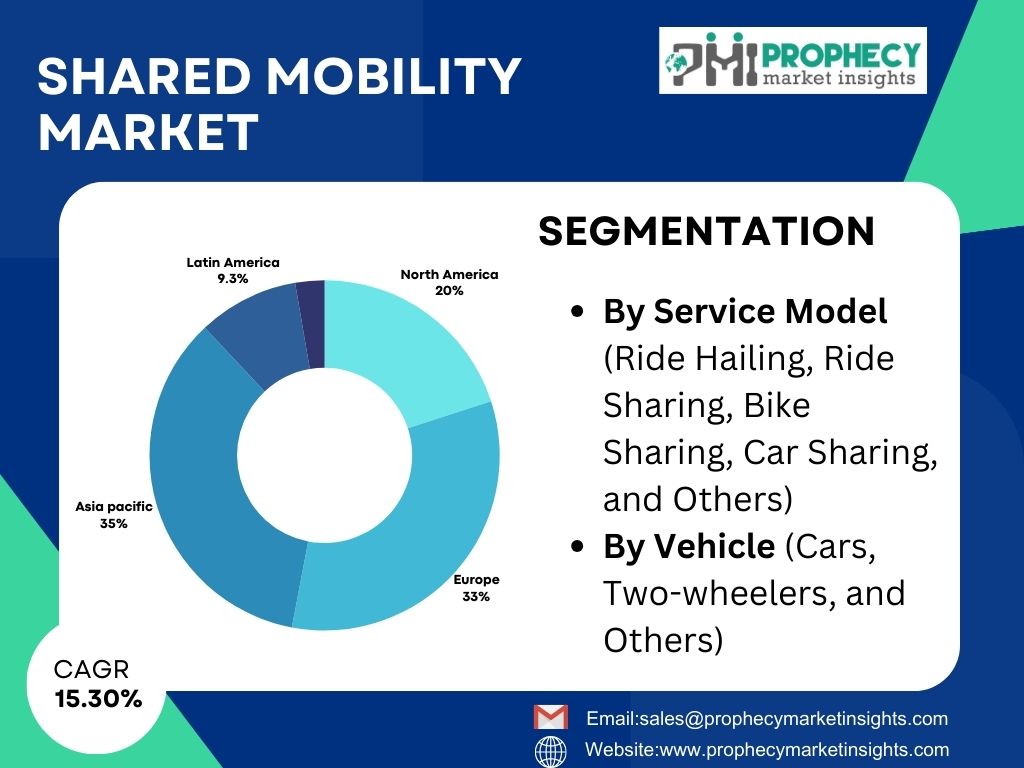
Shared mobility market has emerged as a transformative force in the transportation industry, reshaping how people move and utilize transportation services. Shared mobility refers to the sharing of transportation services, vehicles, and infrastructure, and it encompasses a range of solutions from ride-hailing and bike-sharing to car-sharing and micro-mobility options. This article explores the key trends, challenges, and future prospects influencing the shared mobility market.
Market Size and Growth:
Shared mobility market is estimated to reach US$ 272.4 Billion in 2024 and is estimated to be US$ 1127.1 Billion by 2034 and is anticipated to register a CAGR of 15.30%.
𝗧𝗼 𝗮𝗰𝗰𝗲𝘀𝘀 𝘁𝗵𝗲 𝗳𝘂𝗹𝗹 𝗺𝗮𝗿𝗸𝗲𝘁 𝗿𝗲𝘀𝗲𝗮𝗿𝗰𝗵 𝗿𝗲𝗽𝗼𝗿𝘁, 𝗰𝗹𝗶𝗰𝗸 𝗵𝗲𝗿𝗲:
https://www.prophecymarketinsights.com/market_insight/Global-Shared-Mobility-Market-By-678
Key Trends Shaping the Shared Mobility Market:
- Rise of Ride-Hailing Services: Ride-hailing services, led by companies such as Uber and Lyft, have witnessed unprecedented growth. The convenience of on-demand transportation, coupled with the ease of mobile app booking, has made ride-hailing a popular choice for urban commuters. The market continues to evolve with innovations like ride-pooling and integration with public transit systems.
- Expansion of Micro-Mobility Solutions: Micro-mobility, including e-scooters and bike-sharing, has become a prominent trend in shared mobility. Many cities worldwide are adopting these solutions to address the last-mile connectivity challenge. Dockless electric scooters and bikes offer a cost-effective and eco-friendly alternative for short-distance trips, contributing to reduced traffic congestion.
- Integration of Mobility-as-a-Service (MaaS): Mobility-as-a-Service platforms are gaining traction, providing users with a single interface to plan, book, and pay for various transportation modes seamlessly. MaaS aims to integrate diverse transportation options, including public transit, ride-sharing, and bike-sharing, into a unified, user-friendly experience, promoting sustainable and efficient mobility.
- Electric and Autonomous Vehicles: The shared mobility market is witnessing a shift towards electric and autonomous vehicles. Many ride-hailing and car-sharing services are incorporating electric vehicles (EVs) into their fleets, contributing to environmental sustainability. The prospect of autonomous vehicles further adds a layer of innovation, promising increased efficiency and reduced operational costs in the long term.
Request Your Free Sample Now!
https://www.prophecymarketinsights.com/market_insight/Insight/request-sample/678
Market Segmentation:
- By Service Model (Ride Hailing, Ride Sharing, Bike Sharing, Car Sharing, and Others)
- By Vehicle (Cars, Two-wheelers, and Others)
- By Region (North America, Europe, Asia-Pacific, Latin America, and Middle East and Africa)
Major Players in the Shared Mobility Market:
- Deutsche Bahn AG
- car2go
- Uber Technologies Inc.
- Didi Chuxing Technology Co., Ltd.
- DriveNow GmbH & Co. KG
- ANI Technologies Pvt. Ltd.
- EvCard (SAIC Group)
- Greengo Car Europe Ltd.
- Zipcar, Inc.
- Lyft, Inc.
Download a PDF Brochure:
https://www.prophecymarketinsights.com/market_insight/Insight/request-pdf/678
Challenges Facing the Shared Mobility Market:
- Regulatory Challenges: The shared mobility market faces regulatory challenges as governments and municipalities adapt to the rapid growth of these services. Issues related to licensing, safety regulations, and competition with traditional transportation services require careful consideration to ensure the sustainable growth of shared mobility.
- Infrastructure and Accessibility: The success of shared mobility relies on robust infrastructure and accessibility. To support services like micro-mobility, cities need adequate infrastructure for bike lanes, scooter parking, and charging stations for electric vehicles. Ensuring equal access to shared mobility options across different socio-economic groups is also a challenge that needs attention.
- Public Perception and Safety Concerns: Safety concerns, both real and perceived, impact the adoption of shared mobility services. Incidents involving ride-hailing or micro-mobility vehicles have raised questions about the safety of these services. Building and maintaining public trust through stringent safety measures and transparent communication is crucial for the industry.
- Financial Viability: Achieving financial sustainability remains a challenge for many shared mobility companies. High initial capital investments, operational costs, and intense competition can make it challenging for providers to achieve profitability. Strategies to optimize operations, explore new revenue streams, and establish partnerships are essential for long-term success.
Future Prospects of the Shared Mobility Market:
- Integration of AI and IoT: The future of shared mobility will likely see increased integration of Artificial Intelligence (AI) and the Internet of Things (IoT). These technologies can enhance route optimization, predictive maintenance for vehicles, and real-time data analysis, improving the efficiency and reliability of shared mobility services.
- Collaboration with Public Transit: Collaborations between shared mobility providers and public transit agencies are expected to increase. Integrated solutions that combine ride-sharing, bike-sharing, and public transit options under a unified payment and scheduling system will contribute to more seamless and efficient urban transportation.
- Focus on Sustainability: Environmental sustainability will remain a key focus for the shared mobility market. The adoption of electric vehicles, investment in renewable energy sources, and the development of eco-friendly transportation solutions will play a vital role in shaping the industry’s future.
- Diversification of Services: Shared mobility providers are likely to diversify their services to address a broader range of consumer needs. This could include offerings such as on-demand delivery services, subscription-based mobility plans, and partnerships with businesses for employee transportation solutions.
Conclusion:
The shared mobility market continues to evolve, driven by technological advancements, changing consumer behaviors, and the imperative for sustainable urban transportation. Major players in the industry are navigating challenges while exploring opportunities for innovation and expansion. As shared mobility becomes an integral part of urban ecosystems, collaboration between stakeholders, robust regulatory frameworks, and a commitment to sustainability will be essential for shaping a future where shared mobility is seamless, accessible, and environmentally responsible.
To know more
Contact Us:
Sales
Prophecy Market Insights
📞+1 860 531 2574
✉ Email– sales@prophecymarketinsights.com
🌐 Website- www.prophecymarketinsights.com
🌐 Blog- www.prophecyjournals.com
Follow us on: